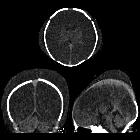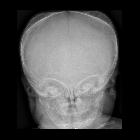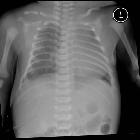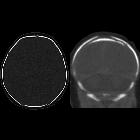birth trauma


Newborn who
experienced prolonged labor. Axial (above), coronal (below left) and sagittal (below right) CT without contrast of the brain show a large low density fluid collection in the subcutaneous tissues of the scalp that crosses sutures and is seen to surround the skull on the coronal view. Intracranially, there is diffuse loss of gray matter-white matter differentiation secondary to diffuse cerebral edema.The diagnosis was caput succedaneum in a patient with hypoxic ischemic encephalopathy.

Angeborene
Pseudarthrose der rechten Klavikula bei einem 3-jährigen Mädchen. Die Fehlbildung war schon im 2. Lebensmonat aufgefallen.

Infant who
had a forceps delivery 3 months ago. AP radiograph of the skull shows bilateral calcified cresenteric areas in the subcutaneous tissues on the top of the skull that do not cross suture lines.The diagnosis was bilateral calcified cephalohematomas.

Birth trauma
• Caput succedaneum - Ganzer Fall bei Radiopaedia

Birth trauma
• Fibromatosis colli - Ganzer Fall bei Radiopaedia

Subdural
hemorrhage • Bilateral cephalohematomas and subdural hematomas - Ganzer Fall bei Radiopaedia

Birth trauma
• Birth trauma - femur fracture - Ganzer Fall bei Radiopaedia

Birth trauma
• Birth trauma - right clavicle fracture - Ganzer Fall bei Radiopaedia

Birth trauma
• Sternocleidomastoid pseudotumor - Ganzer Fall bei Radiopaedia

Birth trauma
• Ping pong skull fracture - Ganzer Fall bei Radiopaedia
Birth trauma (a.k.a. birth injury) relates to those conditions caused by both physical/mechanical and hypoxic injuries.
Epidemiology
Birth trauma occurs in ~5 per 1000 births .
Risk factors
- asphyxia
- breech presentation
- shoulder dystocia
- instrument delivery
- macrosomia
- obstructed labor
Pathology
Etiology
There are a wide range of conditions related to birth trauma, ranging from superficial and minor injuries through to fatal injuries.
Musculoskeletal
- superficial bruising, grazes and lacerations
- caput succedaneum
- cephalohematoma
- long bone fractures, especially clavicular and femoral
- fibromatosis colli
- skull fracture
- vertebral fractures, in particular of C7 and T1
CNS/PNS
- brachial plexus injury
- congenital facial nerve palsy
- intracranial hemorrhage (ICH)
- subdural hemorrhage (most common ICH)
- extradural hemorrhage (rare)
- neonatal hypoxic-ischemic encephalopathy
- spinal cord injury
Differential diagnosis
Birth trauma may not be readily apparent initially, and may have a delayed presentation. Non-accidental injuries can be considered in the neonate in the correct context.
Siehe auch:
- Kongenitale Klavikulapseudarthrose
- Kephalhämatom
- Geburtsgeschwulst
- Geburtstraumatische Claviculafraktur
- birth trauma (physical)
- congenital skull depression
- Geburtstraumatische Humerusfraktur
- Schädelverformung
und weiter:

 Assoziationen und Differentialdiagnosen zu Geburtstraumata:
Assoziationen und Differentialdiagnosen zu Geburtstraumata:
